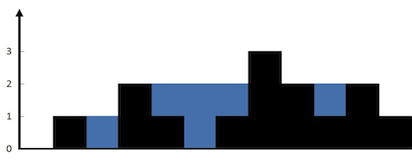Day016 - 42. Trapping Rain Water
업데이트:
42. Trapping Rain Water
Given n non-negative integers representing an elevation map where the width of each bar is 1, compute how much water it can trap after raining.
Example 1:

Input: height = [0,1,0,2,1,0,1,3,2,1,2,1]
Output: 6
Explanation: The above elevation map (black section) is represented by array [0,1,0,2,1,0,1,3,2,1,2,1]. In this case, 6 units of rain water (blue section) are being trapped.
Example 2:
Input: height = [4,2,0,3,2,5]
Output: 9
Constraints:
n == height.length1 <= n <= 2 * 1040 <= height[i] <= 105
내 풀이
class Solution:
def water_cal(self, height):
left_h = height[0]
water_gain = False
water = 0
for i in range(1, len(height)):
if water_gain == False: # 물이 안 고이고 있을 때.
if left_h <= height[i]: # 다음 땅이 왼쪽 기준점보다 높이가 같거나 더 높을 때(물 안고임)
left_h = height[i] # 왼쪽 기준점을 height[i]로 갱신
else: # 다음 땅이 왼쪽 기준점보다 높이가 낮을 때 (물 고임)
water_gain = True # 물 고이는 상태로 전환
water += left_h - height[i] # 왼쪽 기준점을 기준으로 고이는 물의 양 계산
else: # 물이 고이고 있을 때.
if left_h <= height[i]: # 다음 땅이 왼쪽 기준점보다 높이가 같거나 더 높을 때(물이 더이상 고일 수 없음)
water_gain = False # 물이 고이지 않는 상태로 전환
left_h = height[i] # 왼쪽 기준점을 height[i]로 갱신
else: # 다음 땅이 왼쪽 기준점보다 높이가 낮을 때 (물이 계속 고임)
water += left_h - height[i] # 왼쪽 기준점을 기준으로 고이는 물의 양 계산
return water # 고여있는 전체 물의 양을 return
def trap(self, height: List[int]) -> int:
max_h = max(height)
max_idx = height.index(max_h)
height_1, height_2 = height[:max_idx+1], height[max_idx:]
height_2.reverse()
answer = self.water_cal(height_1) + self.water_cal(height_2)
return answer
이번 문제는 난이도가 hard였는데, 생각보다 쉽게 한 번에 풀었다.
# Time Complexity : \(O(N)\)

댓글남기기